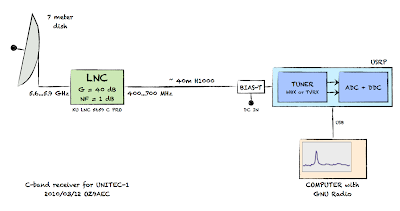I’m sorry to report that despite coordinated efforts between Japanese and European teams we have not been able to receive any signal from UNITEC-1 over Europe. Japanese ground stations were able to receive both the orbit determination downlink and the major/minor data downlink during the first pass after launch; however, the signal has been lost during the first mission day sometime between LOS over Japan and AOS over Europe.
venus
Smaller dish for tracking UNITEC-1
As you probably already know the UNITEC-1 launch got scrubbed today (17th May). Fortunately, there is a launch window every day for the next few weeks.
During the last few days I learned that tracking UNITEC-1 will be very difficult because the available trajectory data can be very uncertain. Therefore, we decided to use a smaller antenna with wider beam width in the first few days after launch. One option was to mount the IKEA dish to piggyback the 7m dish, another option was to use a 90cm dish which is currently equipped with a 2.4 GHz feed. We decided to go for the second option.
C-band Receiver Hardware for UNITEC-1
With only a few days left until the launch of UNITEC-1 (May 17) to Venus, we are getting ready to track it and I am trying to catch up on the documentation part – this time a brief description of the receiver hardware.
Recall the system architecture where the 5.84 GHz RF signal is converted to 640 MHz using the KU LNC 5659 C PRO low noise down converter, and…
This article gives a high level walkthrough of the receiver used to convert the 640 MHz IF to digital baseband, i.e. the blue box called USRP in the above diagram.
UNITEC-1: A New Deep Space Adventure
If everything goes according to current plans, JAXA will launch their PLANET-C spacecraft towards Venus on May 18, 2010. To fill out the empty space and available payload mass on the H-IIA rocket, they will also bring four university built cubesats into orbit. One of these cubesats, UNITEC-1, is very special in that it will … Read more
